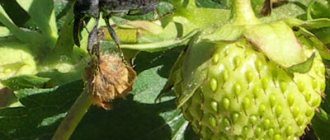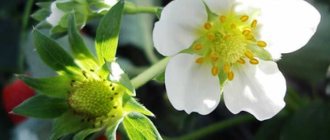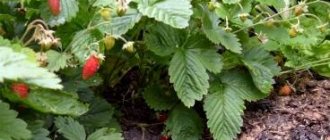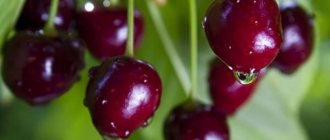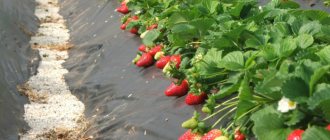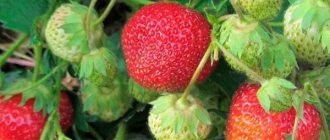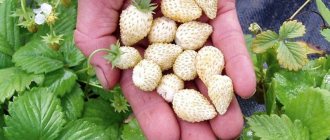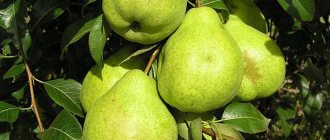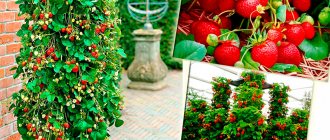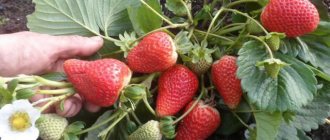Description and characteristics of the variety
Many people call the Alexandrina strawberry variety small-fruited strawberry. It has been grown by many Russian gardeners for more than 25 years. The variety was created in the 90s at the Siberian Horticulture Research Institute named after. Lisavenko. However, it was included in the State Register of the Russian Federation only in 2009. At the same time, strawberries began to be grown en masse in the West Siberian region.
- Strawberry Alexandrina is a remontant variety. It blooms repeatedly and produces berries throughout the season. Remontant strawberries, unlike garden varieties, already bear fruit from May 15-20 until late autumn and the first frost.
- Mid-late ripening period.
- The bushes grow up to 20 cm in height and do not form mustaches.
- The leaves are bright green with slightly jagged edges.
- The inflorescences are semi-spreading, consisting of approximately 6 flowers with small rounded white petals.
- Productivity is high. During the season, the variety bears fruit several times. With proper agricultural technology, 1 bush can produce approximately 0.5 kg, that is, 0.8-1.2 kg per 1 sq. m.
- Reproduction is possible only with the help of seeds.
- Resistant to temperature changes.
- Suitable for cultivation in many regions of Russia.
Description of the variety
Alexandrina is a remontant, beardless variety of alpine strawberry with small fruits. It is believed that garden Alexandrina is well suited for home growing on a windowsill. Often used for aesthetic purposes - in landscape design. It is highly decorative and is successfully used in flower beds, alpine slides and flower beds.
Strawberries of this variety grow in compact bushes, bloom in May, and fruiting begins in June. It bears fruit until about mid-October. Alexandrina's leaves are smooth and rounded. The berries are small (but much larger than wild strawberries), red, sweet and sour.
Growing Alexandrina strawberries from seeds
The main stages of growing high-quality strawberry seedlings of the Alexandrina variety from seeds:
- soaking seed;
- stratification;
- sowing in the ground;
- watering and ventilating seedlings;
- picking;
- hardening;
- transplanting into the ground.
Sowing seeds
For those who want to plant Alexandrina strawberries, growing from seeds is the best way. This is a beardless variety, so classic propagation using rosettes does not work here.
Seedlings are usually planted at the end of February or at the very beginning of March. Take the seeds and soak them for a few days. Some gardeners recommend using snow or rain water for this, which is much softer than tap water. Spread the soaked seeds in an even layer onto a substrate consisting of:
- turf (2 parts);
- peat (1 part);
- sand (1 part).
Heat the prepared substrate in the oven to remove harmful microorganisms and insect eggs.
Seed stratification
After pouring the seeds onto the substrate, place the container in the refrigerator for several days for stratification. Then cover with glass, cling film or a transparent plastic bag, and place in a bright and warm place for germination.
Do not place seedlings in direct sunlight! This will prevent the seedlings from growing.
Caring for strawberry seedlings
To ensure that the seedlings feel good, promptly remove accumulating condensation from the covering glass and water the substrate with clean water at room temperature. Use a pipette or spray bottle to avoid overwatering. Don't forget that the seedlings need to be ventilated!
When several leaves (3-4 pieces) appear on the sprouts, pick up the seedlings. Since the bushes are still small, use a wooden toothpick or any other thin object.
Be careful - strawberry sprouts are very fragile at this moment and can be easily damaged!
During a dive, some bushes may die. After replanting, water the plants so as to prevent drying out or waterlogging. During this period, harden the seedlings - place them in lower temperatures, in drafts, and so on. This is done so that when transplanted into open ground, the pampered strawberries do not die.
Care for the seedlings correctly, and then by the time they are transplanted into the garden, your bushes will be strong and healthy.
Growing
You can plant Alexandria strawberries in your garden by buying seedlings or growing them yourself from seeds. The first method is simpler, but it may happen that, under the guise of one variety, the seller sells a completely different one. Therefore, it is safer to grow seedlings yourself from seeds, which you can buy in a specialized store or collect from yourself.
The first Alexandria bushes appeared on my site by accident. I wanted to experiment, and the idea came to buy strawberry seeds. In the garden store I liked the seeds of this berry. Later, in order not to waste money, I already received my own seeds from my bushes. Their quality was in no way inferior to store-bought ones.
Good reviews are left by buyers of strawberry seeds from Alexandria and “Gavrish”
Sowing seeds for seedlings can be done in January-February for spring planting, as well as in May-June for early autumn planting.
It is convenient to plant seeds in a wide box or small containers. The soil should be light and nutritious. The seeds are laid out at a distance of about 1 cm between them. When the first two true leaves appear, the seedlings are planted in separate pots. Yogurt containers or plastic cups of 100–200 g are perfect for this.
In order for strawberry seedlings to develop well, they need to be planted in the phase of the first two true leaves.
The seedlings obtained in this way can be planted in beds or grown on a windowsill.
Planting in open ground
Before planting strawberry seedlings in a permanent place in the garden, you should dig up the soil a month in advance and add the necessary fertilizers to the soil. Garden strawberries respond well to this composition per 1 m2:
- 1 bucket of vegetable compost or manure;
- 30 g of potassium sulfate;
- 50 g superphosphate.
If preliminary preparation was not possible, you can add a handful of the following composition to each hole immediately before planting:
- 400 g wood ash;
- 1 bucket of compost;
- 2 liters of vermicompost;
- 10 liters of water.
When planting strawberry seedlings, you should adhere to the following recommendations:
- row spacing - about 50 cm;
- depth of planting holes - approximately 25 cm;
- the distance between the bushes is about 30 cm;
- the heart of the bush is not buried and located low, as otherwise this can lead to the death of the plant.
The heart of a strawberry bush should not be buried or placed above ground level.
How to grow on a windowsill
Alexandria also grows well on a window. It looks very impressive as a houseplant and, in addition, pleases with its fruits. To make strawberry bushes feel comfortable at home, you need to choose a pot of about 5 liters. On its bottom you need to put:
- drainage in the form of fine gravel;
- White sand.
The soil should be light and nutritious. You can buy ready-made universal primer or make it yourself. To do this, you need to mix the following components in equal proportions:
- peat;
- humus;
- sand;
- black soil
Plants should be watered as the soil dries out, without over-wetting it.
Alexandria grows well in a pot
Garden strawberry "Alexandrina"
The variety was created at the Siberian Horticulture Research Institute named after. Lisavenko back in the 90s. In 2009, Alexandrina strawberries were included in the State Register with permission for the West Siberian region. The originator is the same research institute/
An important stage in laying out a lawn: preparing the area and soil for sowing grass
Characteristics
| Type: | non-repairable |
| Purpose: | universal |
| Ripening period: | mid-late |
| Fruit weight: | first collection – 20 g, subsequent – 10 g |
| Productivity: | 0.8…1.2 kg/m2 |
| Taste: | good |
| Disease resistance: | No |
Description
Strawberry "Alexandrina" forms tall, semi-spreading, densely leafy plants. The leaves are large, rich green in color, with clearly visible veins and a medium-wrinkled surface. Many leaves are bent along the central vein, and this is clearly visible. The teeth of the leaves are wide, slightly convex. The middle leaf has a rounded shape. The leaf petiole is medium-sized, slightly pubescent, the hairs are pressed to the petiole.
The inflorescences of “Alexandrina” are semi-spreading, with an average of 6.5 flowers per inflorescence. The flowers are medium-sized, untwisted, with white petals.
The berries are round in shape, without a neck. Fully ripe berries are dark red in color, overripe ones are cherry. The weight of the fruits of the first harvest is up to 20 grams, the second and third – up to 10 grams. The taste of the fruit is sweet and sour, good, the tasting score is above 4.0 points, but the register does not say how much higher. Berries contain:
- sugar – 7.4%;
- acids – 0.8%;
- vitamin C – 65 mg/%.
The berries are suitable for fresh consumption, freezing and cooking.
Planting and care
The strawberry variety “Alexandrina” is zoned for only one region of Russia – West Siberian. It is distinguished by relatively high frost resistance, but in other characteristics it is inferior to most modern varieties.
Since the plants are relatively tall and spreading, the strawberry planting pattern should be quite sparse. It would be reasonable to plant plants according to a pattern of 90...100 x 15...20 cm, and subsequently form a second row from the tendrils. In this case, there will be enough space for the plants, and the row spacing will allow you to work in the plantings with relative comfort.
The variety is medium late, and this is a big plus, because late flowering reduces the risk of crop loss due to frost. But there is nothing to reduce: according to the results of variety testing, it is already 0.8...1.2 kg/m2, which is quite modest. Of course, experienced gardeners will be able to get significantly more, but in general “Alexandrina” is not a record holder.
The variety is moderately resistant to drought and disease.
Advantages
- suitability for cultivation in regions with cold winters;
- resistance to freezing;
- tall peduncles;
Flaws
- modest yield;
- insufficiently high disease resistance;
- average drought resistance;
- good but not great taste.
In general, “Alexandrina” is a good variety for regions with cold climates, but that’s all. In the middle zone you can grow much more productive varieties and hybrids.
Reviews
There are no reviews at all about the Alexandrina strawberries.
Description of the strawberry variety Alexandria
The bush reaches twenty centimeters in height. Does not form a mustache. The leaves are bright green, with jagged edges, folded along the central vein. The flowers are white, small, with rounded petals.
The berries are small in size, without a neck, oblong-conical in shape, sharply pointed closer to the top. The average weight of the fruit is 8 g. The color of the berries is red, the surface is glossy. The seeds are noticeable and colored red. The pulp is sweet, very aromatic, with a pronounced strawberry flavor. The berries are used fresh for food, for decorating desserts and baked goods, and for making jam and jelly.
Alexandria strawberries are small, but sweet and aromatic
Landing
Planting dates for Alexandria are standard for remontant varieties. It is best to plant in the spring, as soon as the seedlings sown in containers in February-March have grown. The location is chosen in partial shade; the variety does not like direct sunlight. However, you shouldn’t plant it completely in the shade; if there is a lack of light, the berries will not pick up enough sugar. It has been noticed that the aroma of strawberries grown in the sun is brighter than those from bushes that grew in the shade. The soil must be enriched with a bucket of humus mixed with a glass of ash (per 1 m2).
It is optimal to make a strawberry bed in two lines, leaving an interval of 25-30 cm between the bushes, 0.5 m between the tapes. The holes must be immediately shed with water to shrink the soil. It is advisable to carefully cut off the first burst of flower stalks so that the seedlings spend energy only on rooting.
If you plan to grow Alexandria on the balcony, you will need containers of at least 12 cm in diameter. Be sure to arrange a drainage layer of about 3-4 cm made of expanded clay. It is necessary to provide a tray to drain excess water. Flowering strawberries are pollinated by hand with a brush.
Cultivation time for Alexandria in one place: 3-4 years.
In many characteristics, Alexandria strawberries are similar to another popular variety - Baron Solemacher
Features of growing in pots
Seedlings of the Alexandria variety are planted in containers with a diameter of 12-20 cm, 2-3 bushes each. Strawberryless strawberries do not take up much space. Containers should have a tray and a drainage layer of up to 4-5 cm. Water in the morning and evening so that the soil does not dry out. The soil is periodically loosened with a stick. When the strawberries bloom in the room, pollination is carried out manually. Pollen is transferred with a brush from flower to flower.
Attention! Tips for growing strawberries in pots.
Advantages and disadvantages
The Alexandra variety has many advantages:
- Fruits several times per season.
- Retains its shape when cooked.
- Great taste.
- Keeps well on the bush.
- Resistant to low temperatures.
- Is immune to diseases and pests.
- Beautiful bright leaves, due to which the crop is also used for decorative purposes.
Despite all the advantages, this variety also has disadvantages:
- It does not form a mustache, so the remontant Alexandrina strawberry can only be grown from seeds or by dividing the bush.
- Does not like dry soil.
- In rare cases, it may be susceptible to fungal diseases.
With a competent approach to growing and caring for strawberries, it is possible to avoid damage to the bushes by fungal disease. To do this, you need to adhere to the seedling planting scheme and provide the plants with optimal ventilation conditions.
Care, planting and cultivation of mulberry in central and other zones of Russia and Belarus, black mulberry and other species with photos
Reviews about strawberries Alexandrina
Among gardeners who grew Alexandrina strawberries, the reviews are very varied:
- “this is a very tasty and sweet strawberry that grew on my kitchen windowsill”;
- “I forgot to water it, and there was almost no harvest”;
- “strawberries with mustaches are easier to grow”;
- “the most fragrant and sweet variety I know”;
- “very convenient for those who don’t have a summer house but want strawberries.”
Advantages of Alexandrina strawberries
The main advantages in reviews are usually noted:
- sweetness and taste of berries;
- high productivity;
- ease of cultivation as a potted plant;
- long fruiting season (until frost).
Disadvantages of Alexandrina strawberries
Among the disadvantages, some indicate the following:
- small berry size;
- low yield;
- inconvenience of growing from seeds;
- high cost of seeds compared to other varieties.
Conflicting reviews about yield can easily be explained by non-compliance with the rules for caring for strawberries. Take care of your crops, and they will reward you handsomely!
Have you tried growing strawberries on a windowsill? Share your experience in the comments below.
Features of caring for strawberries Alexandrina
Strawberries of the Alexandrina variety are unpretentious, but insufficient care provokes a decline in yield. To prevent this from happening, consider the following points:
- strawberry Alexandrina loves sunlight;
- the soil should be loose and fertile;
- the area where strawberries are planted should be well ventilated;
- feeding with nutrients is required, otherwise the berries will be small and sour;
- water the strawberries regularly, but not too much;
- be sure to regularly weed and loosen the soil;
- If symptoms of strawberry damage by a mite or weevil appear, be sure to treat it with special medicinal preparations.
Features of planting and care
The strawberry variety Alexandrina is characterized by relatively high frost resistance, so it is preferred in the Western Siberian region of Russia.
Strawberries of this variety are grown from seeds; they must be carefully cared for after germination, and propagation by dividing the bushes is not excluded. When growing from seeds, care consists in making the thin sprouts more stable and stronger; for this they are illuminated with the help of phytolamps and sprinkled with a special substrate. Plants need to be watered regularly; warm water is best for this.
Note! If the seedlings begin to turn their leaves vertically, this means that they do not have enough light.
As soon as 2-3 leaves are formed on the plants, they are immediately planted in separate pots, in which the strawberries are grown for another two weeks, only after that they are once again transplanted into large containers or onto a plot. Before planting seedlings, they are hardened off and the soil is cultivated. The most optimal place for planting strawberries is considered to be a site that is not too sunny.
Since the plants of this variety are quite spreading and tall, it is necessary to plant the plants rarely when planting. As soon as the first flower stalks appear on the strawberries, they need to be carefully removed. This is done so that the plants can grow stronger as needed. At the end of summer, it is necessary to remove reddened leaves.
As for watering, it is recommended to water strawberries no more than twice a week, but this should be done generously. In addition to watering, the crop must be fertilized. A solution of humus, bird droppings, as well as various ready-made fertilizers based on organic substances are suitable for this.
Strawberries Alexandrina for planting
As practice shows, despite the fact that Alexandrina strawberries are considered an unpretentious crop, if you do not provide them with the necessary care, you will not be able to get the expected harvest.
Therefore, the following conditions must be met:
- the soil must be fertile and maintained in a loose state;
- the area where strawberries grow must be constantly ventilated;
- plants must be provided with all the necessary nutrients, otherwise the berries will be sour and small;
- Strawberries should be watered regularly, but not too much.
In order to provide strawberries with protection from pests, it is necessary to treat the soil in the spring with a solution of copper sulfate or Bordeaux mixture.
Alpine strawberry "Alexandrina"
The seeds of this variety are sold everywhere, which is why it is popular. However, this is not the only reason - this is a remontant, arborescent and relatively large-fruited forest alpine strawberry (Fragaria vesca var. alpina) and it is much better than local wild and most varieties of cultivated strawberries.
Characteristics
| Type: | repairable |
| Plant height: | about 15 cm |
| Fruit: | traditional shape, deep red color |
| Fruit weight: | up to 5 |
| Taste: | very good |
Description
Strawberry "Alexandrina" forms vineless plants up to 15 cm high. The leaves are medium in size, rich green in color. The flowers are medium in size, with white, untwisted petals.
The fruits of “Alexandrina” are relatively large, weighing 3...5 grams, and dark red when fully ripe. The pulp is medium density, light. The taste is very good, there is a pronounced strawberry aroma.
Planting and care
When growing Alexandrina strawberries from seeds, they should be sown in February or March. The seeds are not buried, but distributed over the surface of the soil and moistened with a spray bottle. After this, the container with the seeds is covered with glass or wrapped in a bag. Before emergence, the bag is removed daily to ventilate and moisten the soil.
Shoots appear 8...12 days after sowing. After the emergence of seedlings, the container is opened and immediately supplemented with illumination - on the first day around the clock, on the 2nd and 3rd - 18 hours a day, then - about 14 hours. It is necessary to maintain moderate soil moisture.
Plants should be planted in individual pots after two true leaves appear. Strawberries are transferred to a permanent place after the appearance of the fifth true leaf and after the threat of late frosts has passed. Before planting, strawberry seedlings must be hardened off.
The first flowers and berries appear already in the year of planting, but of course there are not many of them. The yield declared here and there - about 300 grams of berries per plant - is rather fantastic. In the second year it is realistic to get about 100, but this is a very good result.
Starting from the second year, strawberries bear fruit from June to September, and if the autumn is warm, then until October. In principle, this is characteristic of all varieties of alpine strawberries.
The variety is relatively winter-hardy: under snow or straw cover, “Alexandrina” tolerates winters near Moscow well.
Advantages
- repairability;
- relatively high yield;
- large berries;
- very good taste.
There is perhaps only one drawback - the lack of a mustache. This greatly limits the possibilities of vegetative propagation.
Reviews
There are relatively many reviews about Alexandrina strawberries, but the information content of the majority is close to zero:
- Moscow region: seed germination from “Aelita” is good, the berries are large, I liked the taste, the yield in the first year is modest;
- Moscow: very poor germination;
- Vladimir region: fairly large red berries, pleasant taste, bears fruit for a long time;
- Leningrad region: overwintered well under a shelter of sheets and non-woven material, grew early, bloomed.
Features of planting and growing strawberries Alexandria
To grow Alexandria strawberries, seedlings are purchased or grown independently from seeds. Propagation by seeds has a number of advantages: the resulting plants are not affected by nematodes, mites and viruses. Often, when buying seedlings at the market, you may not guess the variety, since sellers are not always conscientious. In addition, purchasing seeds is economically profitable, and if you get them yourself, it’s completely free.
It is better not to buy strawberry seedlings at the market, but to grow them yourself from seeds
Technique for obtaining seeds
From the most ripe berries, use a sharp knife to carefully cut off the surface layer of skin with a minimum amount of pulp. Lay out on a paper napkin to dry. After a few days, rub the dried pieces with your fingers, releasing the seeds. There is another way: thoroughly knead the ripe berries in a glass of water. In this case, the pulp floats, and the seeds remain at the bottom. The water with the remaining pulp is poured out, the seeds are decanted and dried.
Obtaining seedlings and planting strawberries
According to reviews, strawberry seeds quickly lose their viability, so it is recommended to start planting immediately after harvesting. However, many gardeners begin growing seedlings at the end of February or beginning of March, and receive the first berries in the same year.
Video: planting seeds
To obtain seedlings from seeds you need:
- Prepare nutrient soil.
- Buy a small plastic container and make holes in it for drainage.
- Fill the container with nutritious soil, compact and level it.
- Water the soil generously with a warm solution of Fitosporin.
- Place a thin white paper napkin, also watered with Fitosporin solution, or a layer of snow on the surface of the soil.
- Pour the seeds into a separate saucer and carefully spread them with a moistened toothpick over a napkin or snow.
A layer of snow should be distributed over the surface of the soil and seeds should be scattered on top
After 3–4 weeks, real leaves will appear on the sprouts
Strawberry seedlings should be picked at the stage of 2–3 true leaves.
Video: growing seedlings
Good lighting is the main condition for obtaining healthy, not elongated seedlings. To keep the seedlings strong, it is recommended to feed the seedlings after the third true leaf appears, using humus or other ready-made fertilizers. For example, Gumi-20M Rich, which, in addition to a complex of fertilizers, also contains Fitosporin, which effectively suppresses the development of fungal and bacterial plant diseases.
Gumi-20M Rich - a fertilizer containing macro- and microelements that provides complete nutrition for plants
Planting in open ground
To plant seedlings in open ground in May, clear a small area, add soil rich in fertilizers or rotted compost, which is sifted and leveled. Seedlings are planted at a short distance from each other for growing. Some gardeners cover seedlings with cut plastic bottles to reduce the stress of transplanting.
To ensure a good strawberry harvest, it is recommended to mulch the soil. There are two types of mulch: organic and inorganic. Organic mulch - rotted sawdust, peat, hay, pine needles. It fertilizes the soil well, but is short-lived. It has to be changed once or twice a season.
Organic mulch fertilizes the soil well, but is short-lived
Inorganic mulch - spunbond, polyethylene film. It is more durable, but does not improve the composition of the soil and, with excess moisture, can cause root rot. Its advantages include the fact that it retains moisture better, suppresses the growth of weeds, and the soil under such mulch warms up faster and retains heat.
When using inorganic mulch, strawberry seedlings are planted through cross-shaped cuts in the material
To plant in a permanent place you need:
- Prepare a bed 100–110 cm wide. Dig up the soil and level it.
- Regardless of the selected mulch, dig holes 25x25x25 cm in the garden bed at a distance of 30 cm from each other and 50 cm between rows.
- Water the holes and plant the seedlings, being careful not to bury the apical bud.
Strawberry seedlings should be planted at a distance of 30 cm from each other and 50 cm between rows
The edges of the film need to be secured around the perimeter of the bed.
After planting seedlings in open ground, it is recommended to pick off the first flowers that appear so that the plants become stronger and take root better.
In most cases, by the end of summer you can taste the first harvest of berries. Strawberries of the Alexandria variety tolerate low temperatures well, so further care for them will not cause much trouble. It is recommended to replant the plantings every three years to obtain a stable, aromatic and healthy harvest.

